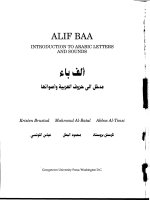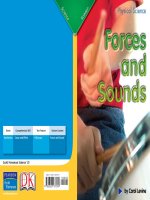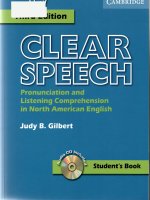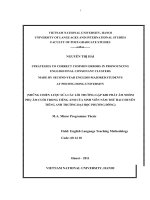clear alphabet spelling and sounds consonant clusters
Bạn đang xem bản rút gọn của tài liệu. Xem và tải ngay bản đầy đủ của tài liệu tại đây (540.76 KB, 8 trang )
Talk a Lot
Learn the Clear Alphabet
Spelling and Sounds – Consonant Clusters
A consonant cluster is a group of two or more consonant letters together in a word. For
example, in the word “brilliant”, “br” is a consonant cluster, as is “ll”, and also “nt”. Consonant
clusters are also sometimes known as “consonant blends”. Focusing on consonant clusters
and vowel clusters (see p.203) is useful if you want to look at some of the differences
between spelling and sounds in English words.
Consonant clusters can occur at the beginning (an initial consonant cluster), in the middle (a
medial consonant cluster) or at the end of a syllable (a final consonant cluster). For example,
in the world brilliant – Bril ynt – which has two syllables, there is a consonant cluster at the
beginning of the first syllable (“br”), at the end of the first syllable (“ll”), and at the end of the
second syllable (“nt”). They can also occur in the middle of a syllable, for example the
consonant cluster “ch” in the middle of the word “ache”.
We can include consonant digraphs within the term “consonant clusters”. A consonant
digraph is where two consecutive consonant letters in the spelling of a word are used together
to make a single sound. For example, in the word “know”, “kn” is a digraph which represents
a single sound: n==. There are also digraphs which make vowel sounds, for example, in the
word “beach”, “ea” is a digraph which represents a single vowel sound: ee==.
There are 21 consonant letters in the English alphabet, and 25 consonant sounds in spoken
English. Therefore we need some consonant digraphs to represent consonant sounds
because there are more consonant sounds than consonant letters. For example, there is no
single letter in English that represents the sound sh . We need to use a digraph – two
consonant letters together – and we end up with “sh” to represent sh . Similarly, there is no
single letter that represents the sound th . Therefore we need to use a digraph – two
consonant letters together – and we end up with “th” to represent th . Confusion can occur
because the digraph “th” also represents another, different consonant sound: tt .
Part of the reason for the existence of digraphs – where two letters make one sound – is that
English is an old language, and over hundreds of years the pronunciation of different words
has changed. Some sounds that used to be pronounced in words are no longer pronounced,
although the spelling has remained the same. Some used to be pronounced, but aren’t any
th
more. For example, up until the mid-17 century “knife” was pronounced in Old English as a
three-syllable word, with the k , the n , and the final vowel sound all heard, like this: k Ni f .
As we have seen in our study of connected speech (see p.11.1 of Talk a Lot Elementary
Handbook), consonants don’t like to rub up against each other, and elision (where we lose a
consonant sound) or assimilation (where a consonant sound changes) often occur when two
consonant sounds meet, to make the syllable or word easier to pronounce. So it is no surprise
then that the longer the consonant cluster, the more difficult it will be to pronounce, and the
more likely it will be that either elision or assimilation take place. For example, try saying:
“twelfths” out loud. This word crowbars seven different consonant letters into one syllable,
which in turn produces six distinct consonant sounds: T w e l f tt z ! Another example of a
problematic word is “crisps”, which is pronounced: Krispz . Try to pronounce all of the five
distinct consonant sounds (in two consonant clusters) in just one syllable. Tricky!
For more fun worksheets, games and quizzes log onto www.englishbanana.com now!
Talk a Lot Elementary
English Banana.com
217
18.39
Talk a Lot
Learn the Clear Alphabet
Spelling and Sounds – Consonant Clusters
Generally speaking most consonant clusters are only two or three letters long. The longest
initial consonant cluster can be three letters long, e.g. “spr-” in the word “sprint”, whilst the
longest final consonant cluster will be generally four letters long, e.g. “-rsts” in the word
“firsts”. Perhaps the prize for the longest consonant cluster would have to go to the word
“rhythm”, which is soley made up of consonant letters – six to be precise! However, “rhythm”
cheats as a consonant cluster, because it actually has two vowel sounds – the “y” acts as the
vowel sound i in the first syllable, which is stressed, and the second syllable contains an
embedded schwa sound: Ri thm .
Adverbs are a group of words that can have long consonant clusters at the end, e.g. exactly.
Elision is likely to occur in such a cluster, for example “exactly” will often be pronounced
without the t sound, like this: i Gza klii rather than==i Gza ktlii . It would be too much
unnecessary effort to try to pronounce the t , sandwiched as it is between two other
consonant sounds. I say unnecessary because the most important sound in this word is the
vowel sound on the stressed syllable, the a sound. This sound must be pronounced clearly,
whilst the consonant sounds are less vital to communication.
Consonant clusters can be divided into five categories:
1.
2.
3.
4.
5.
Consonant Digraphs
Consonant Digraphs with Double Letters
True Consonant Clusters
Consonant Clusters Ending with z
Consonant Clusters in Compound Words
1. Consonant Digraphs
Some consonant clusters are digraphs, which are two letters together in the spelling of a word
that combine to make a single sound. Note that most consonant digraphs end with the letter
“h”. (When three letters come together to form a single sound, e.g. “-tch” in the word “fetch” –
which represents the sound ch – it is known as a trigraph.)
Here are some examples of initial consonant digraphs. (Note: you may wish to add your own
examples in the space provided.)
digraph:
sounds like:
for example:
my example(s):
ch
ch
ch
ch=
sh
k=
=
=
cheer, champion, change
chandelier, champignon 1
cholera, chrome, chronic
______________________
______________________=
______________________=
gn
n=
=
gnat, gnaw, gnome
______________________=
kn
n=
=
know, knife, knitting
______________________=
1
Loan words from French.
For more fun worksheets, games and quizzes log onto www.englishbanana.com now!
Talk a Lot Elementary
English Banana.com
218
18.40
Talk a Lot
Learn the Clear Alphabet
Spelling and Sounds – Consonant Clusters
ph
f=
=
photo, pharmacy, pharaoh
______________________=
rh
r=
=
rhubarb, rhinoceros, rhyme
______________________=
sc
s=
=
science, scissors, scimitar
______________________=
sh
sh=
=
sheep, shine, shock, shed
______________________=
th
th
tt=
th=
=
=
thick, Thursday, thanks
this, that, brother, there, the
______________________=
______________________
ts
s=
=
tsunami1
______________________=
wh
wh
w=
h=
=
=
what, why, where, wheel, whip ______________________=
who, whose, whole, wholemeal ______________________=
wr
r=
=
writing, wrestler, wrong
______________________=
Here are some examples of final consonant cluster digraphs:
digraph:
sounds like:
for example:
my example(s):
ch
ch
ch=
k=
=
=
beach, coach, roach
stomach
______________________
______________________
ck
k=
=
black, track, pick, flock, luck
______________________=
gh
f=
=
cough, trough, rough, enough, tough2 ________________=
mb
m=
=
comb, tomb, aplomb, plumb
______________________=
ng
ng=
=
along, going, eating, meeting
______________________=
sh
sh=
=
finish, trash, Spanish, fish
______________________=
th
tt=
=
tooth, youth, bath, path
______________________
1
This is a loan word from Japanese. In the word “tsar” (from Russian) the “ts” digraph makes a tz sound: Tzar
The digraph “gh” also contributes towards different vowel sounds, e.g. au in “bough” and “plough”, and can be
included in various vowel clusters (see p.215).
2
For more fun worksheets, games and quizzes log onto www.englishbanana.com now!
Talk a Lot Elementary
English Banana.com
219
18.41
Talk a Lot
Learn the Clear Alphabet
Spelling and Sounds – Consonant Clusters
Here are some final consonant digraphs which occur where the letter “r” is silent because it is
helping to make a vowel sound:
digraph:
sounds like:
for example:
my example(s):
rb
b=
=
disturb, suburb, rhubarb
______________________=
rn
n=
=
earn, turn, western, learn
______________________=
rt
t=
=
hurt, heart, art, start, alert
______________________=
Just to confuse you, here’s a consonant cluster where “r” is pronounced. This is not a digraph,
because both of the letters are pronounced, but rather a true consonant cluster:
c/cluster:
sounds like:
for example:
my example(s):
ry
rii=
dairy, eery, diary, hairy, bury
______________________=
=
2. Consonant Digraphs with Double Letters
These consonant clusters are digraphs that comprise a pair of identical letters, which make a
single sound when said together. Most consonant letters can be doubled, although doubles
with “h”, “j”, “q”, “w”, “x”, and “y” are not natural in English. They usually occur in the middle of
a word, although some, like “ff” in “cliff” come at the end. They never occur at the beginning of
a word, unless the word has originated from a foreign language, for example “llama” from
Spanish or “Lloyd” from Welsh. Here is a full list of consonant digraphs with double letters:=
digraph:
sounds like:
for example:
my example(s):
bb
cc
dd
ff
gg
kk
ll
mm
nn
pp
rr
ss
ss
tt
vv
b=
k=
d=
f=
g=
k=
l=
m=
n=
p=
r=
s=
z
t=
v=
robber, sobbing, hobble
soccer, occur, stucco
pudding, wedding, sadder
iffy, cliff , effect, off, effort
boggy, flagged, bigger
trekking, Trekker
alluring, allied, balloon
summer, humming, immature
runner, annoy, announcement
opportunity, shopping, kipper
hurry, worried, curry, sorry
assess, less, massive
possess
shutters, cottage, plotted
revved
______________________=
______________________
______________________
______________________=
______________________=
______________________=
______________________=
______________________=
______________________=
______________________
______________________=
______________________=
______________________
______________________=
______________________=
=
=
=
=
=
=
=
=
=
=
=
=
=
=
For more fun worksheets, games and quizzes log onto www.englishbanana.com now!
Talk a Lot Elementary
English Banana.com
220
18.42
Talk a Lot
Learn the Clear Alphabet
Spelling and Sounds – Consonant Clusters
3. True Consonant Clusters
“True” consonant clusters are phonetic because they are pronounced in the same way as
they are spelled. For example, “br” in “bread” is pronounced in the same way as the
phonemes that it represents: br . In true consonant clusters we pronounce all of the sounds.
Note that the consonant clusters below in bold type are all good examples of when the
consonant sound r is pronounced in an English word. This is helpful to know, because so
often in spoken English the letter “r” in a word is not pronounced, since it’s only there to help
make a vowel sound, for example in the words: “car”, “more”, and “your”.
Here are some examples of true initial consonant clusters:
c/cluster:
sounds like:
for example:
my example(s):
bl
br
cl
cr
dr
fl
fr
gr
pr
qu
scr
sm
st
str
tr
bl
br=
kl=
kr=
dr=
fl=
fr=
gr=
pr=
kw=
skr=
sm=
st=
str=
tr=
blood, blend, black, blown
bright, bring, brush, brilliant
clear, close, clothes, clever
cry, crime, crow, crop, crumb
drink, drop, drive, drip, dreary
flannel, fly, fleece, flame, flow
frighten, from, frame, France
great, grape, grip, grime, grow
prove, provide, pray, princess
quite, queen, quick, quiet1
scream, script, scram, screw
small, smart, smelly, smooth
stay, stop, stink, stolen, sty
strange, stroppy, street, strict
tropical, trench, train, triumph
______________________=
______________________=
______________________=
______________________=
______________________=
______________________=
______________________=
______________________=
______________________=
______________________=
______________________=
______________________=
______________________=
______________________=
______________________=
=
=
=
=
=
=
=
=
=
=
=
=
=
=
=
Here are some examples of true final consonant clusters:
c/cluster:
sounds like:
for example:
ly
mp
mpt
nch
nd
ndy
ny
lii=
mp=
mpt=
nch=
nd=
n dii=
nii=
only, lonely, truly, rarely
______________________
hump, bump, clamp, damp
______________________=
exempt, contempt, dreampt
______________________=
munch, lunch, bench, stench ______________________
end, stand, mend, ground
______________________
windy, candy, handy, sandy ______________________=
tiny, meany
______________________
=
=
=
=
=
=
=
my example(s):
…and here are a couple that are neither initial nor final consonant clusters:
1
Although “qu” is technically a consonant and a vowel together, the sounds that it produces – kw – are both
consonant sounds.
For more fun worksheets, games and quizzes log onto www.englishbanana.com now!
Talk a Lot Elementary
English Banana.com
221
18.43
Talk a Lot
Learn the Clear Alphabet
Spelling and Sounds – Consonant Clusters
c/cluster:
sounds like:
for example:
my example(s):
lv
ng
lv=
nj=
salvage, delve, shelves
orange, arrange, impinge
______________________=
______________________=
=
=
4. Consonant Clusters Ending with z
These are consonant clusters that end with the letter “s”, which represents the sound z= at
the end of a plural noun, for example:
c/cluster:
sounds like:
for example:
my example(s):
nts
rds
rs
ts
ntz=
dz=
z=
tz=
plants, accounts, rents
records, birds, cards, chords
colours, rivers, sisters
sweets, oats, boats
______________________=
______________________=
______________________=
______________________
=
=
=
=
5. Consonant Clusters in Compound Words
In compound words, strange consonant clusters can occur, which are not “true” consonant
clusters. This is because two separate words have been joined together to make a new word,
meaning that the final consonant cluster from the first word has to sit side by side with the
initial consonant cluster from the second word. Here are some examples:
c/cluster:
sounds like:
for example:
the two words are:
tchb
ffh
ndf
ndbr
chb=
fh=
ndf=
ndbr=
switchboard
cliffhanger
grandfather
groundbreaking
switch + board
cliff + hanger
grand + father
ground + breaking
=
=
=
=
As we have seen, it is common when consonant sounds meet for elision or assimilation to
take place (see also Connected Speech, p.11.4 of Talk a Lot Elementary Handbook). So, for
example, we wouldn’t pronounce the whole mouthful of consonant sounds in the middle of
“groundbreaking”: Graund brei king , because it would be too difficult in rapid speech to
pronounce the final consonant cluster “-nd” next to the initial consonant cluster, “br”. On the
contrary, we would automatically employ elision and lose the d sound, changing the word
into: “groun-breaking” – Graun brei king – which is far easier to pronounce.
For more fun worksheets, games and quizzes log onto www.englishbanana.com now!
Talk a Lot Elementary
English Banana.com
222
18.44
Talk a Lot
Learn the Clear Alphabet
Spelling and Sounds – Common Consonant Clusters
A consonant cluster is a group of two or more consonant letters together in a word. They can be initial (at the
beginning of a word), medial (in the middle of a word), and final (at the end of a word). Focusing on consonant
clusters and vowel clusters (see p.203) is useful if you want to look at some of the differences between spelling and
sounds in English words. Consonant clusters can be divided into five categories:
1. Consonant Digraphs (two consonant letters together make a single sound) – INITIAL:
digraph:
sounds like:
for example:
my example(s):
ch
gn
kn
ph
sc
sh
th
th
wh
wr
ch=
n=
n=
f=
s=
sh=
tt=
th=
w=
r=
cheer, champion, change
gnat, gnaw, gnome
know, knife, knitting
photo, pharmacy, pharaoh
science, scissors, scimitar
sheep, shine, shock, shed
thick, Thursday, thanks
this, that, there, the
what, why, where, wheel, whip
writing, wrestler, wrong
______________________
______________________=
______________________=
______________________=
______________________=
______________________=
______________________=
______________________
______________________=
______________________=
my example(s):
=
=
=
=
=
=
=
=
=
=
FINAL:
digraph:
sounds like:
for example:
ch
ck
gh
mb
ng
sh
th
ch=
k=
f=
m=
ng=
sh=
tt=
beach, coach, roach
______________________
black, track, pick, flock, luck ______________________=
cough, trough, rough, enough, tough _________________=
comb, tomb, aplomb, plumb
______________________=
along, going, eating, meeting ______________________=
finish, trash, Spanish, fish
______________________=
tooth, youth, bath, path
______________________
=
=
=
=
=
=
=
2. Consonant Digraphs with Double Letters – MEDIAL:
digraph:
sounds like:
for example:
my example(s):
bb
cc
dd
ll
mm
nn
pp
rr
ss
tt
b=
k=
d=
l=
m=
n=
p=
r=
s=
t=
robber, sobbing, hobble
soccer, occur, stucco
pudding, wedding, sadder
alluring, allied, balloon
summer, humming, immature
runner, annoy, announcement
opportunity, shopping, kipper
hurry, worried, curry, sorry
assess, less, massive
shutters, cottage, plotted
______________________=
______________________
______________________
______________________=
______________________=
______________________=
______________________
______________________=
______________________=
______________________=
=
=
=
=
=
=
=
=
=
=
For more fun worksheets, games and quizzes log onto www.englishbanana.com now!
Talk a Lot Elementary
English Banana.com
223
18.46
Talk a Lot
Learn the Clear Alphabet
Spelling and Sounds – Common Consonant Clusters
3. True Consonant Clusters (that sound the same as they are spelled) – INITIAL:
c/cluster:
sounds like:
for example:
my example(s):
bl
br
cr
dr
fr
gr
pr
qu
scr
sm
st
tr
bl=
br=
kr=
dr=
fr=
gr=
pr=
kw=
skr=
sm=
st=
tr=
blood, blend, black, blown
bright, bring, brush, brilliant
cry, crime, crow, crop, crumb
drink, drop, drive, drip, dreary
frighten, from, frame, France
great, grape, grip, grime, grow
prove, provide, pray, princess
quite, queen, quick, quiet
scream, script, scram, screw
small, smart, smelly, smooth
stay, stop, stink, stolen, sty
tropical, trench, train, triumph
______________________=
______________________=
______________________=
______________________=
______________________=
______________________=
______________________=
______________________=
______________________=
______________________=
______________________=
______________________=
my example(s):
=
=
=
=
=
=
=
=
=
=
=
=
FINAL:
c/cluster:
sounds like:
for example:
ly
mp
nch
nd
ndy
ry
lii=
mp=
nch=
nd=
n dii=
rii=
only, lonely, truly, rarely
______________________
hump, bump, clamp, damp
______________________=
munch, lunch, bench, stench ______________________
end, stand, mend, ground
______________________
windy, candy, handy, sandy ______________________
dairy, eery, diary, hairy, bury ______________________=
=
=
=
=
=
=
4. Consonant Clusters Ending with z==(at the end of a plural noun) – FINAL:
c/cluster:
sounds like:
for example:
my example(s):
nts
rds
ts
ntz=
dz=
tz=
plants, accounts, rents
records, birds, cards, chords
sweets, oats, boats
______________________=
______________________=
______________________
=
=
=
5. Consonant Clusters in Compound Words – (consonant clusters meet) – MEDIAL:
c/cluster:
sounds like:
for example:
the two words are:
tchb
ffh
ndf
ndbr
chb=
fh=
ndf=
ndbr
switchboard
cliffhanger
grandfather
groundbreaking
switch + board
cliff + hanger
grand + father
ground + breaking
=
=
=
=
For more fun worksheets, games and quizzes log onto www.englishbanana.com now!
Talk a Lot Elementary
English Banana.com
224
18.47









